Debt Relief Specialist wants to share a settlement letter from Citizens Bank.
Bal. $2900.94 Offer $2088.68 Savings $812.26

Debt Relief Specialist wants to share a settlement letter from Citizens Bank.
Bal. $2900.94 Offer $2088.68 Savings $812.26

Debt Relief Specialist wants to share a settlement letter from Dell Financial. Bal. $7559.97 Offer $3024.00 Savings $4535.97
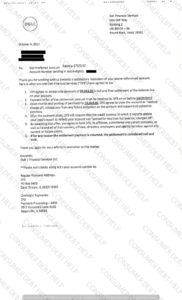
No matter your life stage, managing your household budget is all about priorities–and trade-offs.
One of my friends wouldn’t dream of skipping his opera outings, even though his season tickets cost an arm and a leg. To make up for his periodic musical splurges, he doesn’t mind shopping at Aldi (in fact, he seems to rather like it) and handling his own landscaping and lawn-mowing.
For another person, however, that might be an unacceptable trade-off: Listening to music on CDs at home is just fine, thank you very much, if it means she gets to keep her landscaper and buy organic.
Finding the right balance between sacrifices and necessary splurges is a work in progress: Through a process of trial and error, individuals can identify which expenditures fall into the “must-have” category and which ones they can do without in a pinch.
In this column, I’ll discuss some ideas for cutting your day-to-day living expenses. Note that this isn’t an inclusive list, and a tip that’s right for one person might not be right for another. (That’s why some of these tips might seem to contradict one another.)
1. Go online or review sale fliers to see which grocery store has your favorite products on sale in a given week; just make sure that your savings cover any extra gas money when driving from place to place.
2. Buy frequently used items in bulk when they’re on sale; freeze items you won’t need soon.
3. Stock up during holiday season, when groceries often feature very low prices on basics like potatoes, onions, and baking supplies to get consumers in the door.
4. Resist the urge to overbuy perishables, even if they’re on sale. The most expensive groceries are ones you throw out.
5. Eat more vegetarian meals. You’ll likely save on grocery costs and accrue health benefits at the same time.
6. Make your own croutons, salad dressing, bread crumbs, granola, and pasta sauce. You can control the ingredients and they’ll taste better, too.
7. Grow your own produce: Start small with high-cost, high-margin items like herbs, and graduate to tomatoes, peppers, and zucchini.
8. Print out your own grocery coupons from sites like couponmom.com or your grocer’s website; you can also bypass print coupons and use a coupon app on your smartphone. This article summarizes some of the best sites and apps for grocery coupons.
9. If you live in a large urban center, shop at ethnic food stores, which may have good prices on basics as well as condiments that are often far more costly in a U.S.-style supermarket.
10. Packaged, processed food products are often discounted the most heavily, but don’t skimp on healthful food like high-quality produce and dairy items. Investing in your own health and well-being will pay for itself many times over.
11. Brown-bag or bring leftovers for lunch rather than buying your lunch.
12. By a refillable water bottle and forgo purchased bottled water. Brew your coffee or lattes at home versus going out for them.
13. Buy wine in bulk: Most stores offer a 10% discount on as few as six bottles, even if they’re not all the same type.
14. Cut back on alcohol and make nonalcoholic spritzers instead. (Cranberry juice and San Pellegrino, anyone?)
15. Make your own household cleaners. (Baking soda and vinegar have many cleaning uses, and are earth-friendly, to boot.) Good online recipes abound.
16. Shop discount warehouses such as Costco and Sam’s Club, but only if you won’t buy more than you need.
17. Conduct an audit of your warehouse club usage. If you’re only going a few times a year and you don’t need many of the bulk items on offer, it may not be worth it to pay for the membership.
18. Investigate services like Amazon Prime for subscription prices on recurring purchases like diapers.
General Merchandise
19. Watch out for shipping costs when buying on the Internet; they can quickly erode any savings you realize versus buying the item locally.
20. Services like Amazon Prime can help save time (and perhaps money), but be aware of how easy it is to put the “nice to haves” alongside the “must haves” in your shopping cart.
21. If you’re using an online shopping service such as Amazon Prime, check out what additional services go along with your subscription, such as streaming video or photo storage. You may be able to cut back on paid services in those areas.
22. When shopping for discretionary items, impose a cooling-off period. If you see something you want, wait a week. If you still want it a week later, then pull the trigger.
23. If shopping online, try a virtual splurge. The process of putting the items you want into your shopping cart may provide a shopper’s high, even if you don’t end up forking over your credit card.
24. Refrain from storing your credit card information on an online retailer’s website. Physically entering your information each time may cut down on impulse buys, and it’s also safer from a security standpoint.
25. Look for online coupons on sites such as retailmenot. Typing a retailer’s name into a search engine will also likely turn up a list of coupon codes for that firm.
26. Pay cash rather than using credit cards or checks. Having to hit the ATM and part with actual money can help discourage the desire to spend.
27. Minimize the amount of money you carry in your purse or wallet to help discourage spending on discretionary items such as coffee and magazines.
28. Have a garage (or basement) full of stuff you no longer need? Sell it on Craigslist or eBay.
29. Need stuff? Shop for items you need at flea markets, Craigslist, or eBay. Gently used or vintage items can be more distinctive than new ones, and giving items a second life is greener than buying new.
30. Hold a swap party with friends, where you all bring a few high-quality items that are no longer useful to you. Think kitchen equipment, decorative items for the home, clothes, or accessories.
31. Bargain when purchasing bigger-ticket goods such as appliances; you may have additional leverage if you’re purchasing more than one item.
Utilities/Telecommunications
32. Run appliances at off-peak hours when usage rates are lower.
33. Switch to CFL bulbs or dimmed lights (dimmed lights use less electricity, and may promote romance!).
34. Conduct an energy audit of your home (for example, check air leaks through window frames, door frames, and attics).
35. Turn down heat (or turn up your air-conditioning, depending on the season and the climate where you live). In colder climates, learn to love fleece and buy a warm comforter for your bed.
36. Switch from a premium cable package to a basic one or watch TV online via websites such as hulu.com. Purchasing a digital antenna will give you access to local network channels.
37. If you like your current cable package but it’s been getting more expensive, call your provider to see if you can take advantage of any discount packages available. If that fails, threatening to drop your package should get you results.
38. Head to your local library for DVD rentals; drop your Netflix subscription.
39. If you aren’t using items (such as lamps, VCRs, a clock radio in guest bedroom, and so on), turn them off or unplug them.
40. Switch to energy-efficient appliances when it’s time to replace (or even if it isn’t).
41. Only do full loads of laundry.
43. Hang clothes, sheets, and towels out on the line to dry in the breeze.
44. Fill your dishwasher before running it rather than cleaning partial loads.
45. Drop your phone landline and use your cell phone exclusively instead.
46. Conduct an audit of your cell-phone usage: Cut cell-phone minutes or switch providers. Light cell-phone users are likely to find a prepaid service is more cost-effective than an ongoing subscription. If you’re not a heavy data user, you may be able to get by with just using wi-fi to access data from your phone.
47. Consider sharing cell-phone service with family members or friends; you can usually add additional lines for a small charge per month.
Gasoline/Auto
48. Switch to a more fuel-efficient vehicle. This can be a particularly good idea if you log a lot of miles on the road, but it might not be cost-effective if you don’t drive as much.
49. If you don’t log many miles, investigate a car-sharing service, such as Zipcar, or rent a car rather than paying for maintenance and insurance for your own vehicle.
50. In lieu of taxis, use a service such as Uber or Lyft, which can be more cost-effective.
51. Bike or walk to your destinations, or use public transportation, rather than driving.
52. Take advantage of pretax benefts for users of public transit.
53. Wash your car at home rather than paying for car-washing services.
54. Check out websites like gasbuddy.com to find the lowest gasoline prices in your area.
Home Maintenance
55. Cut your own grass and tackle your own landscaping. You’ll save money and improve your fitness level, too.
56. Reduce your dependence on chemical-based lawn-maintenance services. Your grass might not be as perfect, but you’ll have more money in your pocket and fewer chemicals on your lawn.
57. Drop your house-cleaning service or switch from once-weekly service to once every other week.
Personal Care
58. Experiment with drugstore brands to replace expensive department-store cosmetics.
59. Do your own manicures and pedicures.
60. Stop buying dry-clean-only clothes; learn to iron instead.
61. Walk, bike, run, or work out at a community recreation center rather than paying gym fees.
Insurance/Financial Services
62. Ask if you can qualify for discounts by consolidating homeowners and auto policies with a single firm.
63. Shop around for the best auto and homeowners insurance rates rather than automatically renewing with your current carrier. (Just be sure to the check claims-paying ability and financial stability of a prospective insurer first, using sources like ambest.com.)
64. Ask for a loyalty discount if you decide to stick with the same insurer.
65. Think twice before making small claims on auto and homeowners insurance; the resultant bump-up in premiums could cost you far more than paying for the fix out of pocket.
66. Skip extended warranties. If replacing an item like a computer or a refrigerator wouldn’t put you in a financial bind, it’s usually not worth insuring it.
67. Be scrupulous about paying your bills on time–and not just your insurance bills. Those with the highest credit ratings will qualify for the most advantageous rates.
68. Never let your policies lapse; you may pay a surcharge to reinitiate coverage.
69. Raise your deductible on your auto insurance, especially if you have a history of safe driving and you can afford to pay for smaller fixes out of pocket. Drop or reduce the collision and comprehensive coverage on your auto policy if you drive an older vehicle or one with high mileage.
70. Raise your deductible on your homeowners insurance but ask for a comparison first; the decrease in your premiums may be negligible.
71. Make sure the your homeowners insurance provider is using a realistic value for your home’s replacement cost; the value of the land shouldn’t be included.
72. Live in a disaster-prone area? See if you can qualify for a reduction in homeowners insurance rates by making your home more resistant to natural disasters, such as earthquakes and hurricanes.
73. Ask your insurer if having a home-alarm system or sprinkler system qualifies you for a discounted insurance rate.
74. Paying extra to insure valuable personal articles like jewelry and collectibles? Make sure you still own the items covered. And even if you do, they might be covered under your basic homeowners policy.
75. Investigate what perks come along with your credit card, such as extended warranties or insurance on car rentals.
76. Switch to a credit card with no annual fee, especially if you’re finding it difficult to actually take advantage of the so-called rewards that your rewards card offers.
77. Investigate no-fee cards that pay you cash or rebates back on everyday purchases. Just be sure to read the fine print to ensure that your spending doesn’t have to hit a specific level before the cash-back offer kicks in.
78. If you carry a balance, call your credit card provider to ask for a reduction in your current interest rate. If that doesn’t work, transfer the balance to a card that offers a lower rate. (Just make sure to take stock of any balance-transfer, application, or processing fees; also make sure that your new rate isn’t a teaser rate that will shoot higher before you’ve paid off your balance.)
79. Travel overseas frequently? Avoid foreign transaction fees, which can run as high as 2% or 3%, by switching to a card that offers no foreign transaction fees.
80. Carry a balance on multiple cards? Consolidate those balances in the account that offers the most attractive rate. Again, be careful not to trigger new balance-transfer, application, or processing fees.
81. Investigate credit unions, which may offer higher yields and better loan and credit card rates than banks with a big brick-and-mortar presence (and more overhead expenses).
82. Don’t keep more in a non- or minimal-interest-bearing checking account than you need to; shop around for an account that doesn’t require a minimum balance and park the rest of your cash in a higher-yielding money market fund or certificate of deposit.
83. Ditto for paying fees on your checking account; at this point, it’s not difficult to find no-fee, no minimum balance accounts at firms such as Ally Bank. Online savings accounts can also be a great deal, often offering much higher yields than are available via conventional banks.
84. If you’d like to stick with your current bank but avoid extra fees, ask if your bank will waive fees if you sign on for additional services, such as electronic deposits of your Social Security checks or a money market account.
85. Don’t buy checks from your bank–use a service like Current or Checks in the Mail for low-cost checks instead.
86. Avoid overdraft fees by keeping close tabs on your monthly balance or linking your savings account to your checking. Opt out of overdraft protection, which means that the bank will cover you–and charge you a hefty fee–if you overdraw your account.
87. Watch ATM fees, either by sticking with your bank’s ATMs or opting for a bank that will offer rebates if you use an out-of-network ATM.
88. Pay bills online to save on stamps.
89. Don’t pay for tax-preparation services, especially if you have a straightforward tax return. Many communities offer free tax-preparation assistance.
90. Beware of “rapid refund” offers from tax-preparation firms, which are little more than high-interest loans. If you file your taxes electronically, your refund will come more quickly than you might think.
91. Don’t use prepaid credit cards as gifts for friends and family. Fees can be very high, and cash is much more flexible.
92. Consolidate your investments with a single firm so that you may qualify for lower-cost share classes and lower commission rates.
93. Do you have a small brokerage account that you haven’t touched since the dot-com bust? Close it or add more money to it to avoid ongoing account-maintenance and inactivity fees. Better yet, shop around for a brokerage that doesn’t charge any fees to maintain an account.
94. Don’t overpay for mutual funds. For bond funds, setting an expense ratio cutoff of 0.75% will still keep plenty of good options within reach. You can find many worthy stock funds for 1.00% or less–preferably much less. Index funds and exchange-traded funds, many of which have expense ratios of less than 0.25% per year, are especially appealing from a cost standpoint.
95. Use a low-turnover strategy to reduce the toll that commissions can exact on your investment account’s bottom line. If you actively trade a portion of your portfolio, switch to a provider that offers free online stock and ETF trades.
96. Use limit orders when trading low-liquidity securities to avoid being gouged by large bid-ask spreads; such orders ensure that you’ll only pay a specific, predetermined price for any securities you’re buying.
97. Don’t pay for more financial-planning advice than you actually need. If you need help with a specific task, such as a one-time portfolio overhaul, the hourly model will be more cost-effective than paying a percentage of your assets on an ongoing basis.
98. If your company-provided health savings account custodian levies a lot of fees or fields only high-cost funds, regularly switch out of that HSA and into one of your choosing, as discussed here.
99. Ask for very specific annual cost estimates before signing on for a complicated and costly financial product, such as a variable annuity. If you’re seeing costs of more than 2% or 3% per year, ask your financial advisor whether there are cheaper ways to achieve the same general goals.
100. Mind the tax drag of non-retirement accounts. When selling winning holdings from your taxable account, scout around for losers you can sell to offset the capital gains. Choose tax-efficient holdings for your taxable account, including broad-market index funds and ETFs, tax-managed funds, and municipal bonds and bond funds. Rebalancing? Focus on your tax-sheltered accounts to avoid triggering an unwanted capital gains tax bill.
Staying out of debt should be the goal of every consumer. The problem is that staying out of debt has been given the bad reputation of being no fun. Many consumers associate the concept of financial responsibility with denying themselves the things they want in life. The truth is that using practical tips to stay out of debt can help you to better understand how to have the things you want in life without damaging your financial situation.
Personal financial planning is a two-step process. The first step is to develop the spending and saving policies that will dictate how you handle your finances. Once you have your policies in place, you need to develop the dedication necessary to stay with those policies and learn from them. Rather than fighting the urge to spend money, you should be taking the time to understand how good spending policies lead to the opportunity to live the life you want without falling deep into debt.
The second step in good personal financial planning is turning those policies into habits. If you stay dedicated to making your spending and saving policies a part of your every day decision-making process, then they begin to become second nature. You start to make decisions based on what is best for your personal finances, and you begin to develop the real understanding you need to stay out of debt.
To help you get started, there are five practical tips you can use that will help you avoid debt. Some pieces of advice are not as easy to follow as others. But when you put them together, you get a plan that can help you gain control of your finances and always have your head above water.
1. Budget Your Money
Monitor your spending for two months by keeping a log and collecting receipts. Then segment your spending into expense categories such as entertainment and food. Once you have that information, you combine it with your monthly bills to get a clear picture of your monthly spending habits. Before you start to develop a budget, analyze your spending to find ways to reduce your expenses and free up more money for savings and paying off bills.
Write your bills into a checklist and compare that to your monthly income. As you pay bills or use up expenses, check it off your list. Make your savings accounts bills that you pay every month. Vacations, holiday spending and an emergency savings account should all get something put into them to make sure you have the money when you need it. Any extra money you have at the end of the month goes into the savings account or is applied to paying down the balance of a credit account.
Remember to create expense items for your weekly entertainment, food and gas for your car. Anticipate one-time bills each month and account for them in your budget. Do not deny yourself money for going to the movies each week, but rather you should keep track of it and limit your spending to make sure you have money for important bills and expenses.
2. Make More Money
Is it practical to lower your monthly food budget or put off paying credit card accounts to try and apply that money to other things? No, that is not a practical solution. If you find yourself falling short on your budget each month, then the practical approach is to take on an extra part-time job, pay your bills down and then get your finances under control.
One of the difficult things about budgeting money and being practical with your personal finances is that you need to objectively look at your situation and make hard decisions. If you put yourself in a financial hole, then develop the initiative to get yourself out of that hole by making more money. If you can spend more money, then it is practical to expect yourself to also be able to make more money.
Even if you have a balanced budget and no money problems, if you have the time, then it may not be a bad idea to get an extra part-time job anyways. You can put the money you make into your various savings account and strengthen your financial situation even further. It can be difficult to anticipate the future, and that is why it is always a good idea to take prudent financial action when you are able. Adding money to your savings accounts when you do not feel you need it will create more available funding when you do need it.
3. Credit Cards
A discussion of credit cards is part of practical financial planning because credit cards can offer several benefits that a person with good spending habits can take advantage of. When you are applying for a credit card, look for one that fits your situation. If you travel a lot, then get a card that offers discounts in travel, hotels and rental cars. Look for the card with the best cash-back feature to help you put extra money into your pocket during the course of the year.
The most practical way to use a credit card that offers rewards and cash back is for items that you know you have the cash for in the first place. For example, if you use your credit card to buy groceries, then you can get the benefits of travel miles and cash back while you pay off your entire credit card balance with the grocery money set aside in your budget. Regular expenses that you know you have covered by cash are excellent candidates for credit card spending because you will not be carrying the balance from month to month, but you will still get the rewards credits.
Credit cards are also necessary when it comes to renting a car and doing other activities while traveling or on vacation. Once again, it is practical to have the cash ready to pay the credit card bill when you get it in 30 days. But if you can continue to rack up cash-back payments for spending cash that you have on hand, then that is a good financial move. If you pay the balance within 30 days, then you reduce your interest debt to almost nothing. Learn how to use credit cards responsibly to benefit from them.
4. Save Rather Than Spend
One of the ways that retailers convince people to make large purchases is to entice consumers with low monthly payments on financing. If you know that you can easily make a monthly payment on a financed item, then you should also be able to save the money needed to buy that item in cash.
For example, if you are not in a hurry to get a new television, then you should do some research and find out how much the television you want will cost. Then you can develop a savings plan that will help you to save the money you will need to purchase the item. Look at it as making payments on a finance account for an item you do not own yet. Once you reach your goal, you can purchase the item outright without having to pay interest and finance charges.
Saving money for purchases is always preferable to opening a finance account for the practical consumer. You may have to wait a few extra months for the item but, if the item is not a critical need, then saving for it will allow you to have the things you want without putting yourself into debt.
5. Do It Yourself
Spend time learning how to do tasks that you would normally pay a contractor or professional to do. For example, you can save some money each year by changing your own oil and taking the old oil to a local auto mechanic for disposal. If you have an interest in home remodeling, then start researching ways to do projects on your own rather than paying extra for a contractor to do them.
Any time you get a chance to save money by doing something yourself, the practical approach is to take that opportunity. If you go out to a company party at a facility where there is valet parking, then look to see if you can park your vehicle yourself to save the valet charges. Wash your vehicle each week in your driveway with your own water and supplies to avoid paying for a car wash.
Do not take the “do it yourself” approach to dangerous levels. If a family member needs medical attention, then get to a doctor. But if you find practical ways to save money by doing something on your own, then you should take the chance to save money and avoid putting yourself deeper into debt.
These were our best five tips to easily stay out of debt. Of course these aren’t the only things you could do to stay financially healthy! You can find more effective tips on these links we bundled for you. They’re a great addition to our relatively small website. Good luck!
We certainly understand if the latest IRS imposter scam makes you queasy: it involves a fake IRS tax notice that claims you owe money as a result of the Affordable Care Act.
The IRS says the fake notices are designed to look like real IRS CP2000 notices, which the agency sends if information it receives about your income doesn’t match the information reported on your tax return. The IRS says many people have gotten the bogus notices, which usually claim you owe money for the previous tax year under the Affordable Care Act.
It’s one of many IRS imposter scams that have popped up. As tax season nears, we’ll see more. The good news? There are red-flag warnings that can help you avoid becoming a victim. For example, the IRS will never:
In the new scam, the fake CP2000 notices often arrive as an attachment to an email — a red-flag — or by U.S. mail. Other telltale signs of this fraud:
In the version we saw, a payment voucher refers to letter number LTR0105C, and requests that checks be sent to the “Austin Processing Center” in Texas. But scammers are crafty. They could send messages with a variety of return addresses.
Debt Relief Specialist wants to share a settlement letter from One Main Financial. Bal. $2342.52 Offer $710.00 Savings $1632.52
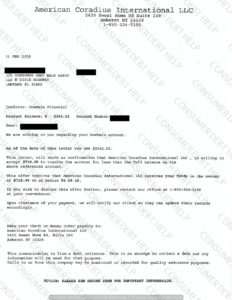
Debt Relief Specialist wants to share a settlement letter from Dell Financial. Bal. $852.06 Offer $342.00 Savings $510.06
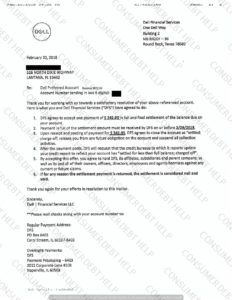
Debt Relief Specialist wants to share a settlement letter from Stein Mart/Synchrony Bank. Bal. $6426.58 Offer $1730.00 Savings $4696.58
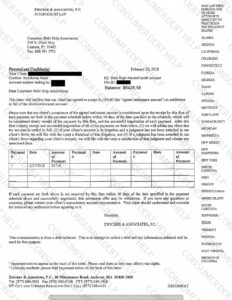
Debt Relief Specialist wants to share a settlement letter from Care Credit/Synchrony.
Bal. $4378.96
Offer $1300.00
Savings $3078.96
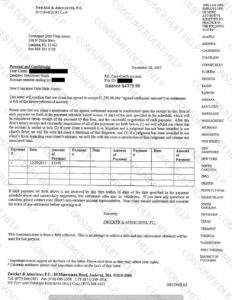
Debt Relief Specialist wants to share a settlement letter from Applied Bank. Bal. $1349.77 Offer $809.86 Savings $539.91
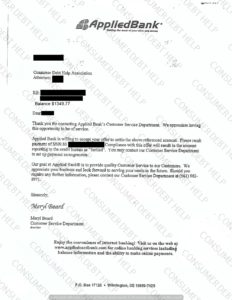
copyright 2024 Consumer Debt Help Association - 516 N. Dixie Highway, Lantana, FL 33462. All Rights Reserved